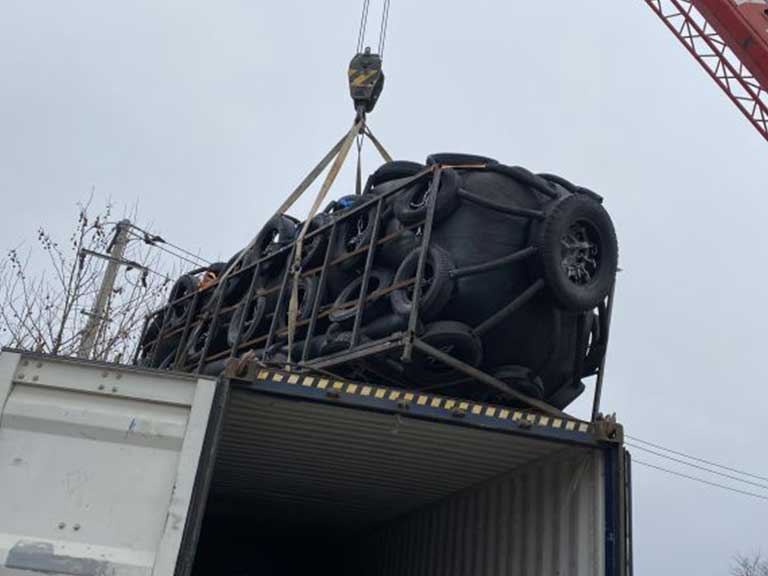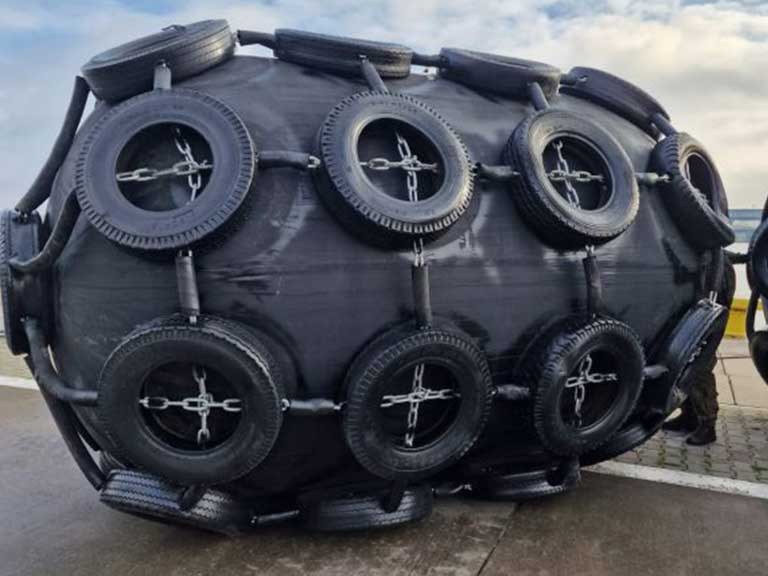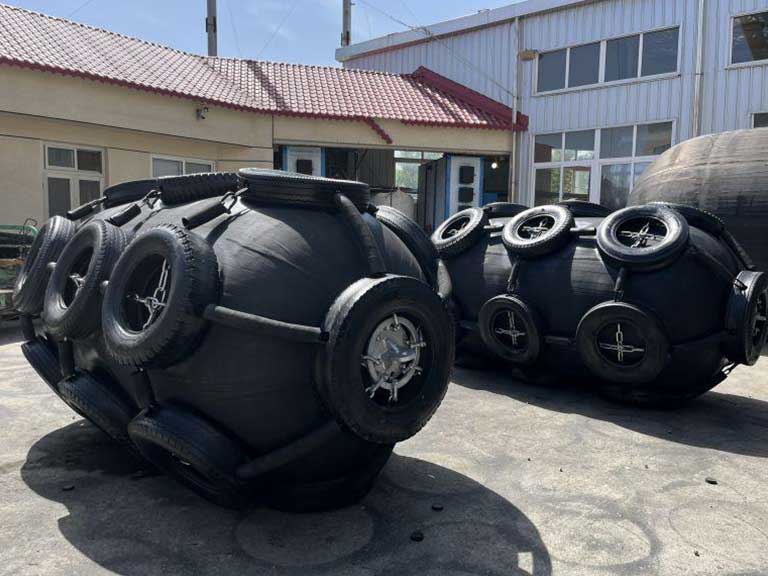Wenn ein großes Schiff andockt, kann es große Schäden verursachen. Schiffsbetreiber brauchen eine Möglichkeit, dies zu verhindern. Pneumatische Fender sind die Antwort.
Henger Shipping Supplies, ein führender chinesischer Hersteller von Schiffsausrüstung, setzt auf Qualität. Wir stellen Fender von Yokohama und Gummifender für die Schifffahrt her. Wir wissen, wie wichtig Schutz auf See ist.
Pneumatische Fender nehmen die Energie auf, wenn ein Schiff andockt. Dadurch werden der Aufprall und der Schaden verringert. Die Yokohama Rubber Company erfand sie 1958. Heute sind sie ein wichtiger Bestandteil der Sicherheit im Seeverkehr.
Wir werden uns ansehen, wie diese Geräte funktionieren, welche Vorteile sie bieten und warum sie für die Sicherheit auf See so wichtig sind.
Inhaltsübersicht
Was sind Yokohama Pneumatische Fender?
Pneumatische Fender werden auch zu Yokohama-Fendern, die aufblasbare Gummigeräte sind. Sie sind dafür gemacht, die Energie beim Anlegen und Vertäuen aufzunehmen. Sie schützen die Schiffe bei diesen Vorgängen vor Schäden.
Was sind pneumatische Fender?
Pneumatische Fender sind aufblasbare Gummivorrichtungen. Sie sind der Schlüssel, um Schiffe sicher im Wasser zu halten. Sie sind in vielen Situationen effektiver als andere Fender.
Komponenten und Konstruktion
Pneumatische Fender bestehen aus drei Teilen: einer äußeren Gummischicht, einer Reifencordschicht und einer inneren Luftblase. Die äußere Schicht ist widerstandsfähig, und die Reifencordschicht sorgt für zusätzliche Festigkeit. Unsere Fender erfüllen die Qualitätsnormen nach ISO 9001-2008.
Die Auswahl der richtigen Materialien ist entscheidend. Die Schichten sind für eine lange Lebensdauer miteinander verbunden. Wir bieten verschiedene Größen und Typen an, die für unterschiedliche Schiffe und Andockanforderungen geeignet sind.

Funktionsweise pneumatischer Fender
Pneumatische Fender funktionieren, indem sie sich bei einem Aufprall zusammendrücken und die Energie absorbieren. Das macht das Anlegen sicherer. Wir erklären, wie sie das machen und wie man sie aufstellt.
Mechanismus der Energieabsorption
Pneumatische Fender funktionieren, indem sie beim Aufprall Luft komprimieren. Dadurch wird der Aufprall abgefedert und die Kraft auf das Schiff und das Dock verringert. Es gibt zwei Hauptschritte: Absorbieren und Ableiten von Energie.
- Die Energieabsorption erfolgt, wenn sich der Fender beim Aufprall zusammendrückt und die Energie des Schiffes aufnimmt.
- Die Energie wird abgeleitet, indem die Luft im Inneren des Fenders die absorbierte Energie verteilt und die Auswirkungen auf das Schiff und das Dock verringert.
Die Luft im Inneren der Kotflügel macht sie flexibel und dennoch stark. So können sie große Stöße abfangen und behalten ihre Form.
| Bühne | Beschreibung | Wirkung |
| Energie-Absorption | Pneumatischer Fender drückt sich bei einem Aufprall zusammen | Absorbiert kinetische Energie |
| Energiedissipation | Druckluft dissipiert die absorbierte Energie | Verringert die Auswirkungen auf das Schiff und das Hafenbecken |
Bereitstellung und Installationsprozess
Einbau von pneumatischen Schutzvorrichtungen umfasst mehrere Schritte. Dazu gehören das Aufblasen, die Überprüfung des Drucks und die richtige Platzierung. Wenn man dies gut macht, kann man sicherstellen, dass sie in verschiedenen Situationen auf See optimal funktionieren.
Wir zeigen Ihnen, wie Sie den Druck am besten aufpumpen und prüfen. Die Position der Schutzbleche ist ebenfalls entscheidend. Er beeinflusst, wie gut sie Stöße absorbieren.
Das Wissen um die Funktionsweise von pneumatischen Fendern hilft den Betreibern, ihre Schiffe und Docks zu schützen. Sie sind ein wichtiges Sicherheitsinstrument auf See.

Vergleich zwischen pneumatischen Fendern und anderen Typen
Es ist wichtig, pneumatische Fender mit anderen Typen zu vergleichen, um ihre Stärken und Schwächen zu verstehen. Pneumatische Fender sind in der maritimen Welt aufgrund ihrer besonderen Eigenschaften sehr beliebt. Aber wie sind sie im Vergleich zu anderen Fendertypen?
Pneumatische vs. schaumgefüllte Fender
Pneumatische Fender und schaumgefüllte Fender sind beide im maritimen Bereich verbreitet. Sie tragen beide dazu bei, Energie zu absorbieren und die Auswirkungen von Zusammenstößen zu verringern. Sie unterscheiden sich jedoch in der Art ihrer Herstellung und ihrer Funktionsweise.
Schaumstoffgefüllte Fender lassen keine Luft entweichen, wenn sie ein Loch bekommen, aber sie absorbieren die Energie nicht so gut, wenn sie beschädigt werden. Pneumatische Schutzbleche hingegen verlieren ihre Funktion, wenn sie ein Loch bekommen. Aber die Luft im Inneren hilft, die Aufprallkräfte gleichmäßiger zu verteilen.
| Fender Typ | Energie-Absorption | Dauerhaftigkeit | Leistung nach Beschädigung |
| Pneumatische Fender | Hohe anfängliche Energieabsorption | Abhängig von der Unversehrtheit des äußeren Gummis | Verliert bei Durchstich seine Funktion |
| Schaumstoffgefüllte Kotflügel | Absorbiert 40% mehr Energie als pneumatische Fender (laut einigen Berichten) | Widerstandsfähiger gegen Durchstiche | Verminderte Energieabsorptionsfähigkeit nach Beschädigung |
Langlebigkeit und Leistungsunterschiede
Die Haltbarkeit und Leistung pneumatischer Fender im Vergleich zu schaumstoffgefüllten Fendern ist entscheidend. Pneumatische Fender absorbieren Energie gut, sind aber auf die Integrität ihrer äußeren Gummischicht angewiesen.
Schaumstoffgefüllte Fender hingegen funktionieren auch nach einer Beschädigung noch einigermaßen, wenn auch nicht mehr so gut. Die Wahl zwischen pneumatischen und schaumgefüllten Fendern hängt von den Bedürfnissen des Schiffes und den Einsatzbedingungen ab.
Anwendungen von pneumatischen Fender
Wir befassen uns mit den vielfältigen Einsatzmöglichkeiten von pneumatischen Fendern in der Seeverkehrssicherheit. Sie schützen Schiffe und Strukturen bei verschiedenen maritimen Einsätzen.
Schiff-zu-Schiff-Transfers
Pneumatische Fender sind entscheidend für Schiff-zu-Schiff-Transfers. Sie schützen beim Transfer von Ladung und Flüssigkeiten zwischen Schiffen. Ihre Fähigkeit, Energie zu absorbieren, und ihre geringen Reaktionskräfte machen sie dafür perfekt.
Schiff-zu-Terminal-Operationen
Im Schiff-Terminal-Verkehr schützen pneumatische Fender Schiffe beim Anlegen in Häfen und Terminals. Sie können an unterschiedliche Gezeiten angepasst werden und gewährleisten die Sicherheit von Schiffen und Bauwerken.
Offshore-Plattformen und Marineoperationen
Pneumatische Fender werden auch im Offshore- und Marinebereich eingesetzt. Sie bieten einen starken Aufprallschutz für Plattformen, Schiffe und U-Boote. Dank ihrer Flexibilität sind sie für viele Umgebungen und Anforderungen geeignet.

Wartung und Langlebigkeit von pneumatischen Fender
Pneumatische Fender benötigen wenig Wartungaber regelmäßige Kontrollen sind der Schlüssel zu ihrer langen Lebensdauer. Sowohl pneumatische als auch schaumgefüllte Fender benötigen nur minimale Pflege. Pneumatische Fender müssen jedoch etwa einmal im Jahr mit Luft gefüllt werden, damit sie gut funktionieren.
Andererseits benötigen schaumstoffgefüllte Fender keine Luft, was ihnen einen leichten Vorteil bei der Wartung verschafft. Luftgefüllte Fender sind jedoch auch ohne Luft leicht zu bewegen und sparen Platz. Für die Lagerung ist es am besten, sie teilweise mit Luft zu füllen, damit das Gummi in guter Form bleibt.
Bei richtiger Pflege können pneumatische Schutzbleche 8 bis 10 Jahre halten. Wir betonen die Notwendigkeit regelmäßiger Kontrollen und des richtigen Aufpumpens. Wenn Sie diese Schritte befolgen, verlängert sich ihre Lebensdauer, was sie zu einer soliden Wahl für den Einsatz auf See macht.
FAQ
Was ist die Hauptfunktion der äußeren Schicht eines pneumatischen Schutzblechs?
Die äußere Schicht aus zähem Gummi schützt vor Stößen und Abschürfungen. Sie hilft auch, die Kraft von Stößen zu verteilen.
Wie absorbieren pneumatische Fender die Energie beim Anlegen oder Festmachen?
Pneumatische Fender absorbieren Energie, indem sie Luft im Inneren komprimieren. Dies reduziert die Aufprallkraft und schützt Schiffe und Strukturen.
Was sind die Hauptunterschiede zwischen pneumatischen Schutzblechen und schaumgefüllten Schutzblechen in Bezug auf die Leistung?
Pneumatische Fender können Energie besser absorbieren und Aufprallkräfte besser bewältigen als schaumgefüllte Fender. Sie sind oft die erste Wahl für schwierige Anwendungen.
Wie oft sollten pneumatische Fender inspiziert und gewartet werden, um eine optimale Leistung zu gewährleisten?
Es ist wichtig, die pneumatischen Schutzbleche regelmäßig zu überprüfen und zu warten. Achten Sie auf Verschleiß, Schäden oder Luftlecks. Führen Sie bei Bedarf Routinewartungen durch.
Können pneumatische Fender in verschiedenen Meeresumgebungen eingesetzt werden, z. B. auf Offshore-Plattformen und bei Marineeinsätzen?
Ja, pneumatische Fender sind vielseitig. Sie eignen sich hervorragend für den Transfer von Schiff zu Schiff, den Betrieb von Terminals und den Einsatz auf See. Sie können gut Energie absorbieren und Aufprallkräfte reduzieren.
Welche Faktoren sollten bei der Auswahl eines pneumatischen Fenders für eine bestimmte Anwendung berücksichtigt werden?
Bei der Auswahl eines pneumatischen Fenders sollten Sie die Größe und den Typ des Schiffes, die Anlegebedingungen und den Energieabsorptionsbedarf berücksichtigen. Berücksichtigen Sie auch das erforderliche Aufprallkraftmanagement.

